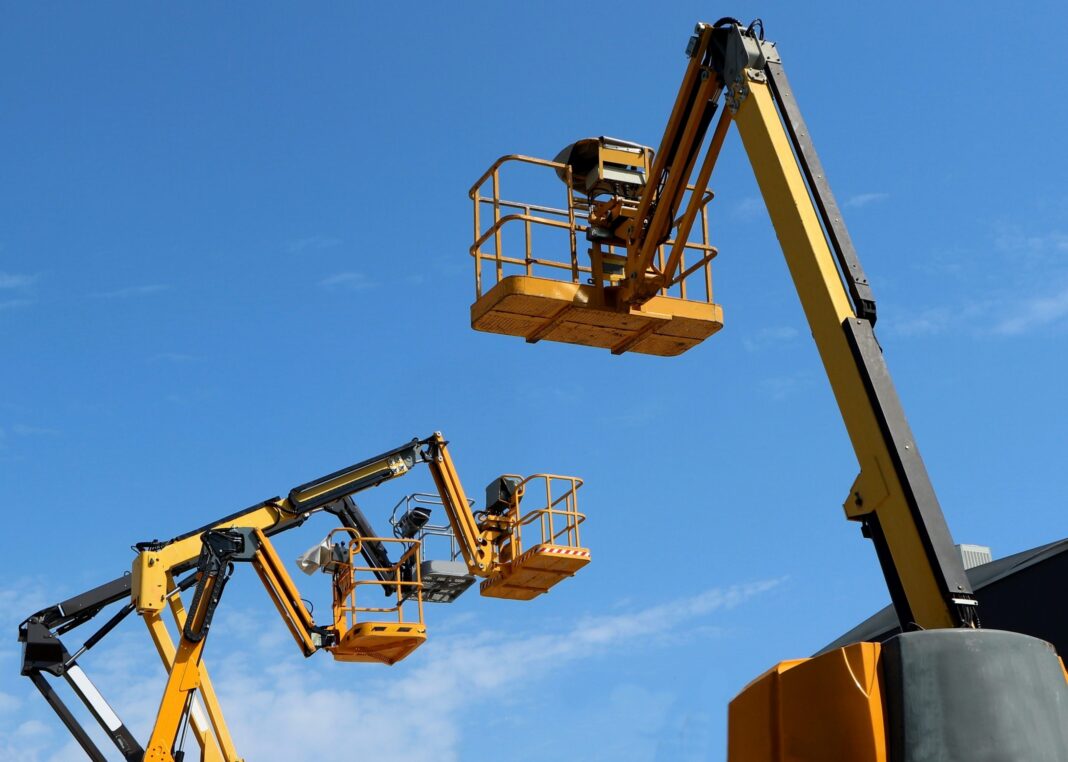OPERATING AERIAL WORK PLATFORMS SAFELY
Aerial work platforms are a basic apparatus used to securely lift faculty. These valuable platforms come in different sizes and arrangements, including truck mounted platforms, scissor lifts, boom and telescopic lifts and spider crawler platforms. Show more aerial work platform models on www.centroelevatori.com. At the point when a support or development worker must play out an errand at a raised working position, these amazing machines are frequently approached to carry out the responsibility. This program examines a portion of the basic dangers that aerial work platform administrators must think about when utilizing this gear just as the protected work rehearses and working methods that must be pursued to ensure everybody’s security during the utilization of an aerial work platform.
Points incorporate the pre-operational inspection,
1- Testing the working controls,
2- Inspecting the way of movement,
3- Driving securely,
4- Raising the platforms securely,
5- Safe work practices and bringing down the lift.
PROGRAM OUTLINE:
PREPARING AND AUTHORIZATION
- Before working on an aerial work platform, the administrator must be appropriately prepared and qualified just as approved by their boss to do as such. There are numerous models and styles and each type has special working and soundness qualities. This is the reason administrators must be prepared on the particular type of lift they will work and should get extra preparing before being permitted to work some other type of lift.
- Operator preparing will incorporate comprehension of basic risks, for example, the elements that influence soundness and preventing tip-overs, staying away from electrical cables and fall assurance.
- Operator preparing will likewise incorporate guidance for the best possible activity of all lift controls, including the emergency stop controls and other emergency controls.
- Operators should likewise have a comprehension of the data contained in the hardware administrator’s manual and the area and significance of the different wellbeing decals showed on the gear.
- Operators should likewise be prepared to play out an exhaustive pre-operational inspection of the hardware before use. At long last, before getting to be approved to utilize an aerial work platform, an administrator must have the option to show the aptitudes and learning expected to securely work the particular type of lift for which they have been prepared.
- Operators who are associated with an occurrence or are watched working a lift inappropriately may lose their working benefits or might be approached to experience retraining.
THE PRE-OPERATIONAL INSPECTION
The pre-operational inspection is a significant piece of utilizing any lift. Its motivation is to confirm that the hardware and the majority of its parts are in safe working condition. Keep in mind, your life relies upon the best possible activity of your lift.
Start your underlying inspection by finding the proprietors and upkeep manuals. These manuals must remain installed the lift consistently. This is significant with the goal that the manual can be counseled when extra data about the lift is required.
Next, circle the aerial work platform and search for any free or broken parts, liquid releases, basic harm or some other markers of harm or risky conditions. Give uncommon consideration to fuel and water-driven lines, air hoses, links, and wire outfits. Make sure that they are free of harm and give no indications of spilling.
Check the tires for a legitimate track, exorbitant wear, cuts or inserted objects. At the point when pertinent, make sure all tires are swelled to the producer’s suggested pneumatic force. Numerous lifts have liquid levels that must be checked. Be sure oil, pressure-driven liquid, fuel, and coolant are all at a suitable level.
All wellbeing and cautioning bulletins must be set up and clear. Investigate guardrails and doors. They ought not to have split welds or any missing parts. On the off chance that the lift has a swinging entryway, it should just swing internal. Check that it can’t swing outwards. A few styles of lifts have outriggers or stabilizers. If so, ensure they work appropriately and are not harmed or broken. Contingent upon the make and model of your platform, the maker may prescribe extra checks before use. Counsel the proprietor’s manual or inquire as to whether you are unsure about a lift’s inspection prerequisites.
TESTING THE OPERATING CONTROLS
Upon the finish of the underlying inspection of the platform, you should then test and working and emergency controls. Aerial work platforms have two arrangements of controls. This enables the lift to be worked starting from the earliest stage as well as from the platform. The controls on the body of the lift are for the most part alluded to as the lower level controls while the controls on the platform are normally called the upper-level controls. The capacity of these controls must be tried and checked preceding use.
Start with testing the capacity of the lower-level controls. Test every development of the platform to make sure all controls are working appropriately. Likewise, affirm that the lower level of an emergency stop is working as it should. At that point turn the selector change to choose the upper-level controls so they might be tried. Notwithstanding the controls used to move the platform, the upper-level controls likewise incorporate the driving controls for the lift.
Test the forward and turn around controls just as the guiding controls. Additionally, a test that the brakes are working appropriately. At that point test the controls that lift, lower and control the platform to make sure each control works true to form. Numerous lifts highlight a two-hand control framework that requires a different catch to be held down before any control can be initiated. At the point when present, this framework must be confirmed operational. It prevents the incidental development of the lift if the controls are inadvertently knocking.
Different types of lifts highlight a foot pedal for this equivalent reason. If so, test it to ensure that all development is stopped when the foot pedal is discharged. At last, make certain to test the upper-level emergency stop button. On the off chance that you find any imperfections or harm during the pre-operational inspection, pursue your organization’s methodology for expelling the vehicle from the administration so it tends to be appropriately fixed. Never work a faulty or harmed lift.
THE PATH OF TRAVEL
Numerous wounds and episodes including aerial work stages happen while the lift is moving. One approach to counteract these occurrences is to investigate the planned path of travel for obstacles and hazards before moving the lift. Investigate the course and search for any flotsam and jetsam or obstacles that are standing out. Expel any things that are in your path or may meddle with your capacity to move the lift into position. Likewise search for drop-offs, delicate or temperamental soil, inclines, potholes or checks. These things can make a lift become unlevelled and can add to a spill. In the event that there are any extension plates, meshes or different covers in your path, make sure they are safely set up and can bolster the weight of your lift. It is likewise imperative to look overhead. Make sure your path takes into account legitimate freedom under overhead obstacles. On the off chance that the work zone or travel course is in the path of an overhead crane, the crane must be kept and labeled out of administration to avert any clashes between moving crane loads and the aerial work stage.
MOUNTING THE LIFT AND DRIVING SAFELY
We should now talk about how to appropriately mount the lift and some sheltered driving contemplations to ensure that you and the lifted land at the chose work zone securely. To start with, advise any colleagues in the influenced territories that you are getting ready to move the vehicle to the work zone. At that point, check to make sure nobody is near or under the lift. To mount the lift, face the vehicle decisively and move into the stage while keeping up a decent grasp and three points of contact while climbing. Watch your head in the event that you are required to dodge under a fixed guardrail.
Abstain from getting or knocking any operational controls when mounting the lift and abstain from stepping on any foot controls. Promptly close any entrance entryways and secure any chains or guardrails in the wake of mounting. Once securely inside the stage, join your cord to one of the maker’s affirmed stay focuses. Try not to associate your cord to the guardrail. Before first moving the lift, and when moving in tight spaces, check the situation of the wheels to make sure you comprehend which heading the lift will go. Blast lifts have a decal that demonstrates which heading is forward travel and which course is turn around travel. Once more, make sure you comprehend which bearing the lift will go before moving it. When driving the lift, keep the stage completely brought down and travel at a speed that will enable you to dodge blocks and associates securely.
Numerous lifts have a selector switch which confines the lift’s speed. If so, place the lift in moderate mode when working in tight regions, close to drop-offs or while raised. While driving, face the course of travel and often check clearances around, above and beneath the unit. On the off chance that your view is discouraged, have a colleague fill in as a spotter to help manage you around obstacles and to look for other moving hardware. Avoid making sharp turns and abrupt stops, particularly when traveling at higher rates. These kinds of moves can rapidly prompt damage.
Plan ahead and delayed down before you have to turn or stop. Before driving up or down a slope, make sure its evaluation doesn’t surpass your vehicle’s prescribed rating for these surfaces. Continuously completely bring down the lift before driving on a slope. In the event that you have to stop the vehicle and leave it unattended, bring down the stage, shut off the motor and apply the leaving brake on the off chance that it has one. At that point pursue your association’s arrangement for averting unapproved use which may incorporate removing the key or different methods.
RAISING THE AERIAL WORK PLATFORM SAFELY
When you have landed at the work zone, you should make sure the vehicle is steady and level before raising the stage. Upon appearance, make sure you have stopped the lift on a firm, level surface. On the off chance that you are outside, observe the breeze conditions. Try not to raise the stage if winds surpass the producer’s suggestions. The lift will be outfitted with a tilt caution that will initiate if the vehicle is in excess of five degrees out of level.
Try not to hoist the lift on an inclined surface. In the event that the lift is outfitted with balancing out gadgets, for example, outriggers, they should be sent. The feet of any stabilizers must be put on firm ground and the stabilizers changed in accordance with ensuring the lift is level. Sweep the region above, underneath and around the stage for other workforce or hazards before raising, turning or expanding the lift’s foundation. Know about the lift’s weight capacity. The absolute weight, all things considered, gear, and faculty must not surpass this weight capacity. You can confirm the weight capacity of your lift by alluding to the proprietor’s manual or checking the fitting admonition decal or the lift’s information plate. An over-burden lift will become too top-substantial when raised and may become shaky and turn over. Continuously keep hands and other body parts inside the stage while the stage is moving. This is to avert squashing or squeezing body parts against stationery items. Continuously remain caution to overhead obstacles that could strike your head as the lift moves or as you play out your work. To maintain a strategic distance from electric shock, be additional careful when hoisting in the region of electrical cables and other electrical hardware. Keep up base freedom of 10 feet from stimulated parts or wires up to 50,000 volts. Allude to the proprietor’s manual for freedom separations for higher voltages.
SAFE WORK PRACTICES

We should now discuss some safe work practices to follow once you have arrived at the working position. Keep the platform floor free of deterrents and flotsam and jetsam that could cause a slip or excursion. Make sure instruments, control lines and other hardware are situated in zones where you won’t stand or strolling. You should have the option to play out your work with the two feet on the floor. In the event that you can’t arrive at your work, you should raise the platform or reposition it. Never stand or sit on the guardrails and never use stools, stepping stools or different articles to arrive at higher. Once more, you should work with your feet level on the floor. Keep your cord associated with the producer’s endorsed tie-off point consistently while you are on the platform.
The reason for wearing an outfit and cord is to keep you safely inside the platform while you work. The platform’s guardrails fill in as the essential wellspring of fall insurance. Never associate your cord to any object outside the platform. While playing out your work, be mindful so as not to surpass your lift’s even burden or “side load” rating. Unreasonable side burdens can make a lift spill. This significant data can be found in the proprietor’s manual and is likewise every now and again showed on the lift itself. Likewise, remain ready when using cables, ropes, and hoses. Should these things become ensnared while moving the lift, the powers created can undoubtedly cause a spill?
Using your platform as a crane to derrick loads, or using a rope to lift apparatuses and supplies, can likewise make the lift unstable and significantly improve the probability of a spill. Never take part in this perilous practice.
BRINGING DOWN AND DISMOUNTING THE LIFT
When you have finished up the raised work, it is significant that you bring down the lift in a safe way and afterward park and descent the lift safely. When your work is finished and you are prepared to bring down the platform, make sure that the encompassing zone is clear of hardware, staff, and different obstacles. The bringing down systems on the lift can make an extreme squeeze guide peril toward any close by work force.
As the lift brings down, keep body parts inside the guardrails and watch out for any strings or cables to ensure that they don’t wind up caught. Make sure the lift or any of its instruments don’t progress toward becoming gotten on any strong article while bringing down. When all work is finished and the lift is completely brought down, it should be come back to its legitimate stockpiling area.
When getting off the lift, face the vehicle and keep in touch while cautiously slipping to the floor or ground. As the administrator of an aerial work platform, you convey an enormous dependably. Set your preparation in motion by working your lift in a safe and cautious way. Continuously recollect, the individual most liable for your safety is you.


